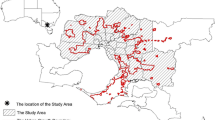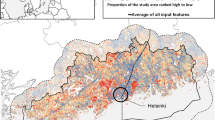Abstract
Graph-theoretic approaches are increasingly popular in the representation and analysis of ecological networks, acting as a complement to traditional techniques, particularly to perform connectivity analysis. Local network indices are useful to identify portions of an ecological network that are worth inspecting, such as bottlenecks. However, the simple identification of cut nodes may turn out to be insufficient. By providing criteria to rank identified cut nodes, land managers are able to assess priorities for further local analysis.
Access this chapter
Tax calculation will be finalised at checkout
Purchases are for personal use only
Similar content being viewed by others
References
Welcome to JGraphT—a free Java Graph Library. http://jgrapht.org/
Bergsten, A., Zetterberg, A.: To model the landscape as a network: a practitioner’s perspective. Landsc. Urban Plan. 119, 35–43. http://www.sciencedirect.com/science/article/pii/S0169204613001254 (2013). https://doi.org/10.1016/j.landurbplan.2013.06.009
Cannas, I., Zoppi, C.: Ecosystem services and the natura 2000 network: a study concerning a green infrastructure based on ecological corridors in the metropolitan city of Cagliari. In: Computational Science and Its Applications—ICCSA 2017. Lecture Notes in Computer Science, pp. 379–400. Springer, Cham (2017). https://doi.org/10.1007/978-3-319-62407-5_27
Dyer, R.J., Nason, J.D.: Population Graphs: the graph theoretic shape of genetic structure. Mol. Ecol. 13(7), 1713–1727 (2004). https://doi.org/10.1111/j.1365-294X.2004.02177.x
Fenu, G., Pau, P.L.: Evaluating complex network indices for vulnerability analysis of a territorial power grid. J. Ambient Intell. Humaniz. Comput. 1–10 (2015). https://doi.org/10.1007/s12652-015-0264-0
Fenu, G., Pau, P.L., Dessì, D.: Functional models and extending strategies for ecological networks. Appl. Netw. Sci. 2(1), 10 (2017). https://doi.org/10.1007/s41109-017-0032-5
Jongman, R.H.G.: Nature conservation planning in Europe: developing ecological networks. Landsc. Urban Plan. 32(3), 169–183 (1995). https://doi.org/10.1016/0169-2046(95)00197-O
Loro, M., Ortega, E., Arce, R.M., Geneletti, D.: Ecological connectivity analysis to reduce the barrier effect of roads. An innovative graph-theory approach to define wildlife corridors with multiple paths and without bottlenecks. Landsc.0 Urban Plan. 139, 149–162. http://www.sciencedirect.com/science/article/pii/S0169204615000602 (2015). https://doi.org/10.1016/j.landurbplan.2015.03.006
Mazaris, A.D., Papanikolaou, A.D., Barbet-Massin, M., Kallimanis, A.S., Jiguet, F., Schmeller, D.S., Pantis, J.D.: Evaluating the connectivity of a protected areas’ network under the prism of global change: the efficiency of the European natura 2000 network for four birds of prey. PLoS ONE 8(3), e59640 (2013). https://doi.org/10.1371/journal.pone.0059640
McRae, B.H., Dickson, B.G., Keitt, T.H., Shah, V.B.: Using circuit theory to model connectivity in ecology, evolution, and conservation. Ecology 89(10), 2712–2724 (2008). https://doi.org/10.1890/07-1861.1
Moilanen, A.: On the limitations of graph-theoretic connectivity in spatial ecology and conservation. J. Appl. Ecol. 48(6), 1543–1547 (2011). https://doi.org/10.1111/j.1365-2664.2011.02062.x
Pereira, M., Segurado, P., Neves, N.: Using spatial network structure in landscape management and planning: A case study with pond turtles. Landsc. Urban Plan. 100(1–2), 67–76. http://www.sciencedirect.com/science/article/pii/S0169204610002926 (2011). https://doi.org/10.1016/j.landurbplan.2010.11.009
QGIS Development Team: QGIS Geographic Information System. Open Source Geospatial Foundation. http://qgis.osgeo.org (2009).
Urban, D.L., Minor, E.S., Treml, E.A., Schick, R.S.: Graph models of habitat mosaics. Ecol. Lett. 12(3), 260–273 (2009). https://doi.org/10.1111/j.1461-0248.2008.01271.x
Vimal, R., Mathevet, R., Thompson, J.D.: The changing landscape of ecological networks. J. Nat. Conserv. 20(1), 49–55. http://www.sciencedirect.com/science/article/pii/S1617138111000471 (2012). https://doi.org/10.1016/j.jnc.2011.08.001
Acknowledgement
This essay is written within the Research Program “Natura 2000: Assessment of management plans and definition of ecological corridors as a complex network”, funded by the Autonomous Region of Sardinia (Legge Regionale 7/2007) for the period 2015–2018, under the provisions of the Call for the presentation of “Projects related to fundamental or basic research” in year 2013, implemented at the Department of Mathematics and Computer Science of the University of Cagliari, Italy.
Author information
Authors and Affiliations
Corresponding author
Editor information
Editors and Affiliations
Rights and permissions
Copyright information
© 2018 Springer International Publishing AG
About this paper
Cite this paper
Fenu, G., Pau, P.L. (2018). Identification of Critical Habitat Corridor Patches by Cut Node Ranking. In: Cherifi, C., Cherifi, H., Karsai, M., Musolesi, M. (eds) Complex Networks & Their Applications VI. COMPLEX NETWORKS 2017. Studies in Computational Intelligence, vol 689. Springer, Cham. https://doi.org/10.1007/978-3-319-72150-7_50
Download citation
DOI: https://doi.org/10.1007/978-3-319-72150-7_50
Published:
Publisher Name: Springer, Cham
Print ISBN: 978-3-319-72149-1
Online ISBN: 978-3-319-72150-7
eBook Packages: EngineeringEngineering (R0)




